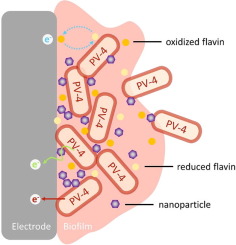当前位置:
X-MOL 学术
›
Bioelectrochemistry
›
论文详情
Our official English website, www.x-mol.net, welcomes your
feedback! (Note: you will need to create a separate account there.)
Synergistic improvement of Shewanella loihica PV-4 extracellular electron transfer using a TiO2@TiN nanocomposite.
Bioelectrochemistry ( IF 4.8 ) Pub Date : 2020-03-28 , DOI: 10.1016/j.bioelechem.2020.107519 Lin Su 1 , Tao Yin 2 , Hongxiu Du 2 , Wen Zhang 2 , Degang Fu 3
Bioelectrochemistry ( IF 4.8 ) Pub Date : 2020-03-28 , DOI: 10.1016/j.bioelechem.2020.107519 Lin Su 1 , Tao Yin 2 , Hongxiu Du 2 , Wen Zhang 2 , Degang Fu 3
Affiliation

|
Extracellular electron transfer (EET) allows microorganisms to perform anaerobic respiration using insoluble electron acceptors, including minerals and electrodes. EET-based applications require efficient electron transfer between living and non-living systems. To improve EET efficiency, the TiO2@TiN nanocomposite was used to form hybrid biofilms with Shewanella loihica PV-4 (PV-4). Chronoamperometry showed that peak current was increased 4.6-fold via the addition of the TiO2@TiN nanocomposite. Different biofilms were further tested in a dual-chamber microbial fuel cell. The PV-4 biofilm resulted a maximum power density of 33.4 mW/m2, while the hybrid biofilm of the TiO2@TiN nanocomposite with PV-4 yielded a 92.8% increase of power density. Electrochemical impedance spectroscopy analyses showed a lower electron-transfer resistance in the hybrid biofilm. Biological measurements revealed that both flavin secretion and cytochrome c expression were increased when the TiO2@TiN nanocomposite presented. These results demonstrated that the TiO2@TiN nanocomposite could synergistically enhance the EET of PV-4 through altering its metabolism. Our findings provide a new strategy for optimizing biotic-abiotic interactions in bioelectrochemical systems.
中文翻译:

使用TiO2 @ TiN纳米复合材料协同改善希瓦氏菌PV-4的胞外电子转移。
细胞外电子转移(EET)允许微生物利用不溶性电子受体(包括矿物质和电极)进行厌氧呼吸。基于EET的应用需要在有生命和无生命系统之间进行有效的电子转移。为了提高EET效率,使用TiO2 @ TiN纳米复合材料与Shewanella loihica PV-4(PV-4)形成杂化生物膜。计时电流分析法表明,通过添加TiO2 @ TiN纳米复合材料,峰值电流增加了4.6倍。在双室微生物燃料电池中进一步测试了不同的生物膜。PV-4生物膜的最大功率密度为33.4 mW / m2,而TiO2 @ TiN纳米复合材料与PV-4的混合生物膜的功率密度增加了92.8%。电化学阻抗谱分析显示杂化生物膜中较低的电子转移电阻。生物学测量表明,当出现TiO2 @ TiN纳米复合材料时,黄素分泌和细胞色素c表达均增加。这些结果表明,TiO2 @ TiN纳米复合材料可以通过改变其代谢来协同增强PV-4的EET。我们的发现为优化生物电化学系统中的生物-非生物相互作用提供了新的策略。
更新日期:2020-03-28
中文翻译:

使用TiO2 @ TiN纳米复合材料协同改善希瓦氏菌PV-4的胞外电子转移。
细胞外电子转移(EET)允许微生物利用不溶性电子受体(包括矿物质和电极)进行厌氧呼吸。基于EET的应用需要在有生命和无生命系统之间进行有效的电子转移。为了提高EET效率,使用TiO2 @ TiN纳米复合材料与Shewanella loihica PV-4(PV-4)形成杂化生物膜。计时电流分析法表明,通过添加TiO2 @ TiN纳米复合材料,峰值电流增加了4.6倍。在双室微生物燃料电池中进一步测试了不同的生物膜。PV-4生物膜的最大功率密度为33.4 mW / m2,而TiO2 @ TiN纳米复合材料与PV-4的混合生物膜的功率密度增加了92.8%。电化学阻抗谱分析显示杂化生物膜中较低的电子转移电阻。生物学测量表明,当出现TiO2 @ TiN纳米复合材料时,黄素分泌和细胞色素c表达均增加。这些结果表明,TiO2 @ TiN纳米复合材料可以通过改变其代谢来协同增强PV-4的EET。我们的发现为优化生物电化学系统中的生物-非生物相互作用提供了新的策略。











































 京公网安备 11010802027423号
京公网安备 11010802027423号